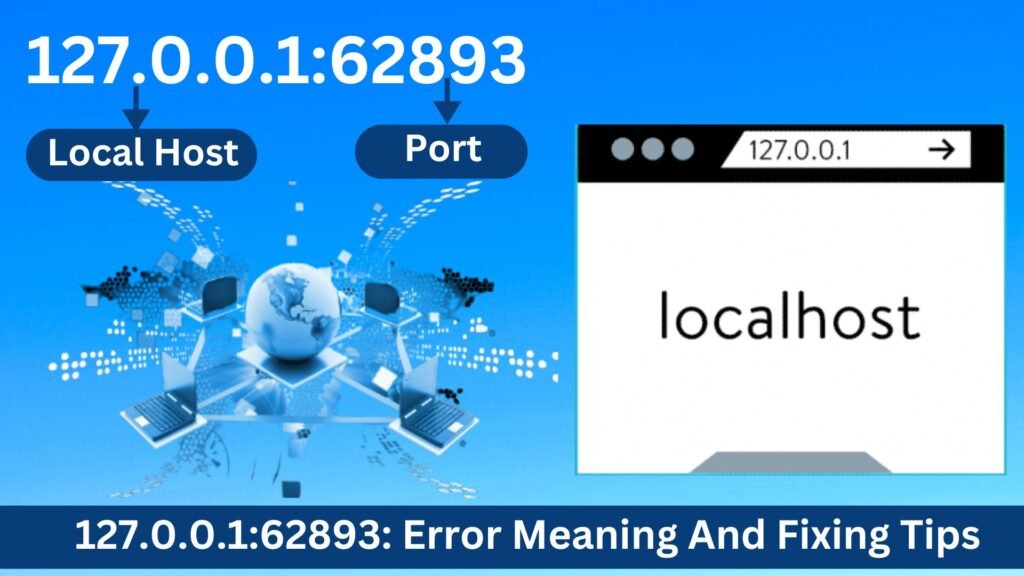Introduction
Have you ever stumbled upon the error message 127.0.0.1:62893 and wondered what it meant? You’re not alone. This cryptic combination can be frustrating, especially when it disrupts your workflow. Understanding the underlying issues and knowing how to address them can save you a lot of headaches. Let’s dive into what this error is all about and how you can fix it.

Table of Contents
What is 127.0.0.1?
127.0.0.1 is often referred to as the “localhost” address. In networking terms, it’s a loopback address that points back to your own computer. When you access 127.0.0.1, you’re essentially telling your computer to connect to itself. This address is commonly used for testing and development purposes because it allows you to run a server or application locally without needing an internet connection.
Understanding Port 62893
Ports are like doorways through which data enters and exits your computer. Each port is associated with a specific process or service. Port 62893 is not a standard port, which means it’s likely used by a specific application or service on your machine. Knowing which application uses this port is key to understanding and resolving related errors.
Common Causes of 127.0.0.1:62893 Error
Several factors can lead to the 127.0.0.1:62893 error. Here are the most common ones:
- Software Configuration Issues: Incorrect settings within an application can prevent it from communicating properly.
- Firewall or Security Software Interference: Overzealous security settings can block necessary connections.
- Network Configuration Problems: Misconfigured network settings can lead to connectivity issues.
- Application-Specific Issues: Certain applications might have bugs or require specific settings to function correctly.
Identifying the Error
The 127.0.0.1:62893 error typically manifests as a connection failure or timeout. You might see error messages like “Connection refused” or “Unable to connect to server.” Recognizing these messages can help you diagnose the problem more quickly.
Initial Troubleshooting Steps
Before diving into complex solutions, start with these basic troubleshooting steps:
- Check the Software Configuration: Ensure the application settings are correct and that it’s configured to use the correct port.
- Verify Firewall Settings: Make sure your firewall isn’t blocking the connection. You might need to add an exception for the application.
- Ensure Proper Network Setup: Verify that your network settings, such as IP address and DNS configurations, are correct.
Advanced Troubleshooting Techniques
If basic steps don’t resolve the issue, consider these advanced techniques:
- Use Command-Line Tools for Diagnostics: Tools like
netstatandtelnetcan help you check if the port is open and if the application is listening. - Analyze Logs for More Details: Check the application’s logs for any error messages or clues about what might be going wrong.
- Isolate the Problem: Try running the application on a different machine or network to see if the issue persists.
Fixing Software Configuration Issues
If the problem lies within the software configuration, consider the following steps:
- Update or Reinstall the Software: Sometimes, simply updating or reinstalling the software can fix configuration issues.
- Correct Configuration Files: Double-check the configuration files to ensure all settings are correct.
- Ensure Compatibility with Other Software: Make sure the application is compatible with other software on your machine.
Firewall and Security Software Solutions
To resolve firewall-related issues, try these steps:
- Configure Firewall Rules: Adjust the firewall settings to allow traffic through port 62893.
- Whitelist Necessary Applications and Ports: Ensure that your firewall or security software allows the application to communicate.
- Temporarily Disable for Testing: If you’re unsure if the firewall is the issue, temporarily disable it and check if the error persists.
Network Configuration Solutions
Network settings can also be a culprit. Here’s what to check:
- Router and Modem Settings: Ensure that your router and modem are configured correctly and not blocking the port.
- IP Address and DNS Settings: Verify that your computer’s IP address and DNS settings are correct.
- Reset Network Devices: Sometimes, simply resetting your router or modem can resolve connectivity issues.
Application-Specific Fixes
Different applications may require unique fixes. Here are some examples:
- Web Servers: Ensure that your web server software is configured to listen on port 62893.
- Database Servers: Check database server settings and ensure proper user permissions and configurations.
- Other Common Applications: Refer to the application’s documentation for specific troubleshooting steps.
Preventive Measures
To avoid encountering this error in the future, consider these preventive measures:
- Regular Updates and Maintenance: Keep your software and systems up to date to prevent compatibility issues.
- Backing Up Configuration Files: Regularly back up your configuration files so you can easily restore them if needed.
- Monitoring Network Activity: Use network monitoring tools to keep an eye on your system’s performance and catch issues early.
When to Seek Professional Help
If you’ve tried all the above steps and the error persists, it might be time to seek professional help. Look for reliable IT support services that can diagnose and fix the problem for you.
Conclusion
Understanding and fixing the 127.0.0.1:62893 error can be daunting, but with the right approach, it’s manageable. Start with basic troubleshooting, move on to more advanced techniques if necessary, and don’t hesitate to seek professional help if needed. Keeping your systems updated and properly configured will go a long way in preventing such errors in the future.
FAQs
What is the significance of 127.0.0.1?
127.0.0.1 is the loopback address, often referred to as localhost. It’s used to establish a connection to your own computer for testing and development purposes.
How do I know if port 62893 is open?
You can use command-line tools like netstat or telnet to check if port 62893 is open and if an application is listening on it.
Can I change the port number if I keep getting errors?
Yes, you can often change the port number in the application’s configuration settings. Just ensure the new port is not being used by another service.
How do I reset my network settings?
You can reset your network settings by restarting your router and modem or by using system tools to reset network configurations on your computer.
What should I do if none of the troubleshooting steps work?
If none of the troubleshooting steps work, it might be time to seek professional help from IT support services. They can provide a more in-depth analysis and solution.
Also Read More:
Blog.VnCallCenter.Com: Your Premier Source for Business Intelligence, CRM Tools and More
Share To Help
